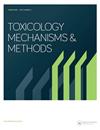鱼藤酮通过NF-κB–iNOS途径对大鼠肝脏毒性的影响
IF 2.8
4区 医学
Q2 TOXICOLOGY
引用次数: 13
摘要
摘要鱼藤酮作为一种杀虫剂已经使用多年,它是一种引起神经系统疾病的环境毒物。然而,鱼藤酮对大鼠肝脏的影响以及毒性机制尚不清楚。在本研究中,Sprague-Dawley(SD)大鼠被分为五组:对照组、二甲基亚砜(DMSO)组、鱼藤酮低剂量组(1 mg/kg),鱼藤酮中剂量(2 mg/kg)和鱼藤酮高剂量(4 mg/kg)。每天口服治疗28天,我们评估了健康状况、炎症因子mRNA表达水平、蛋白质水平、一氧化氮(NO)含量和组织学变化。结果显示,与对照组相比,每个鱼藤酮组的体重都以剂量依赖的方式显著降低。与对照组相比,鱼藤酮组的环氧化酶-2(COX-2)、核因子κB(NF-κB)、前列腺素E2(PGE2)、诱导型一氧化氮合酶(iNOS)和肿瘤坏死因子(TNF-α)的mRNA水平均显著升高,但低剂量组的iNOS和TNF-αmRNA表达除外。与对照组相比,每个鱼藤酮组的COX-2蛋白水平均显著升高,NF-κB蛋白在鱼藤酮中高剂量组和低剂量组的表达显著升高,但低剂量组没有,与对照组比较,NO含量也发生了类似的变化。此外,组织学分析显示,最严重的组织损伤发生在高剂量组。这些结果表明鱼藤酮对大鼠肝脏具有与炎症因子有关的毒性作用。我们的研究结果提供了对鱼藤酮肝毒性机制的深入了解。本文章由计算机程序翻译,如有差异,请以英文原文为准。
The effects of rotenone-induced toxicity via the NF-κB–iNOS pathway in rat liver
Abstract Rotenone has been used as a pesticide for many years, it is an environmental poison reported to cause neurological diseases. However, the effects of rotenone on the rat liver are unclear, as are the mechanisms of toxicity. In the present study, Sprague–Dawley (SD) rats were divided into five groups: control, dimethyl sulfoxide (DMSO), rotenone low-dose (1 mg/kg), rotenone mid-dose (2 mg/kg) and rotenone high-dose (4 mg/kg). The treatments were orally administered daily for 28 days, we assessed health status, mRNA expression levels of inflammatory factors, protein levels, nitric oxide (NO) content and histological changes. The results showed that body weight was significantly decreased in each rotenone group in a dose-dependent manner, compared with the control group. Rotenone significantly increased the mRNA levels of cyclooxygenase-2 (COX-2), nuclear factor kappaB (NF-κB), prostaglandin E2 (PGE2), inducible nitric oxide synthase (iNOS) and tumor necrosis factor (TNF-α) in each rotenone group compared with the control group, except iNOS and TNF-α mRNA expression in the low-dose group. The protein levels of COX-2 were significantly higher in each rotenone group compared with the control group, NF-κB protein expression were significantly higher in the rotenone mid and high-dose groups, but not in the low-dose group, compared with the control group, similar changes were observed in NO content. Additionally, histological analysis revealed that the most severe tissue damage occurred in the high-dose group. These results indicated that rotenone has toxic effect in rat liver relating to inflammatory factors. Our findings provide insight into the mechanisms of rotenone hepatotoxicity.
求助全文
通过发布文献求助,成功后即可免费获取论文全文。
去求助
来源期刊

Toxicology Mechanisms and Methods
TOXICOLOGY-
自引率
3.10%
发文量
66
期刊介绍:
Toxicology Mechanisms and Methods is a peer-reviewed journal whose aim is twofold. Firstly, the journal contains original research on subjects dealing with the mechanisms by which foreign chemicals cause toxic tissue injury. Chemical substances of interest include industrial compounds, environmental pollutants, hazardous wastes, drugs, pesticides, and chemical warfare agents. The scope of the journal spans from molecular and cellular mechanisms of action to the consideration of mechanistic evidence in establishing regulatory policy.
Secondly, the journal addresses aspects of the development, validation, and application of new and existing laboratory methods, techniques, and equipment. A variety of research methods are discussed, including:
In vivo studies with standard and alternative species
In vitro studies and alternative methodologies
Molecular, biochemical, and cellular techniques
Pharmacokinetics and pharmacodynamics
Mathematical modeling and computer programs
Forensic analyses
Risk assessment
Data collection and analysis.
 求助内容:
求助内容: 应助结果提醒方式:
应助结果提醒方式:


